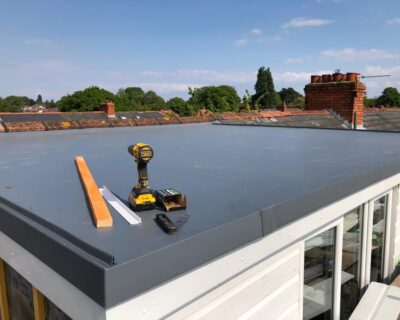Blog & News

What’s Involved in a Flat Roof Inspection?
Having a roof over your head should never be taken for granted, just as it should never be taken for granted that your roof is in good condition.
Your roof is constantly exposed to the elements as it protects your house from harsh weather conditions, so it’s not surprising that certain issues occur over time.
Flat roofs are particularly prone to water damage, and if you live somewhere wet like Doncaster, your roof is probably working double time! Especially in Autumn and Winter (and Spring) when the rainy season… continues.
If you’ve never had your flat roof inspected before, then you might not know what to expect. We hope this article gives you a good idea of what’s involved, but it’s always best to have a professional perform your flat roof inspection. They’re able to spot issues or damage that might not be visible to the untrained eye.
Why Should You Have a Flat Roof Inspection?
The roof plays a huge part in the structure of your house, and if exposure to the elements means it becomes damaged it could end up causing problems in other areas of your home.
It doesn’t matter whether your roof was built with felt or asphalt, over time general wear and tear are unavoidable. Flat roofs require an even higher level of maintenance, so it’s best to have your roof inspected every few years as most of these issues get worse over time.
The Inspection – What’s Involved?
When carrying out a flat roof inspection, your surveyor will carry out external and internal checks to look for the following issues. They’ll need access to your roof and loft to see the true extent of any damage.
An exterior inspection will examine:
- Leaks
- Poor tile condition
- Seals
- Guttering or drain blockages
- Chimney pointing
- Structural damage
- Rot, fungus, or decay
An interior inspection will examine:
- Loft damage
- Insulation
- Ventilation
- Excess moisture or condensation
- Rot, mould, or decay
But what do some of these common roof problems mean for your roof, and how do you check for them?
Flat Roof Issues
Pooling
Standing water is a common problem with flat roofs due to there being no way for water to naturally drain away, and it’s easy enough to spot.
It’s probably one of the most common issues, and it’s one you’ll want to deal with as soon as possible. You might have always fancied yourself a rooftop pond, but this isn’t the type of pond you want.
At the very least, it can leave unattractive watermarks and patches of discolouration as the water evaporates. At worst, it can also cause the material of your roof to deteriorate or create divots in the surface to trap even more water.
Moreover, if water is pooling on your roof then the laws of physics dictate that it’s going to try to find an escape.
One guess for where you think the water is going to end up going.
Leaks
You guessed it. If water is pooling on the top of your flat roof, it’s most likely going to make its way inside your home eventually. But this isn’t the only thing that can cause leaks inside your home.
When performing a flat roof inspection the surveyor will be checking to see if there are any damaged tiles, cracks in your chimney’s pointing, or flashing that’s coming away from the wall, as these can all cause water leaks.
If left unattended, leaks can cause rotting and even structural damage if the ceiling joists or fascia boards are badly affected. They also lead to increased moisture and condensation, which brings us to our next issue.
Fungus
Vegetation is another consequence of water build-up, including moss, lichen, and weeds, which all flourish in moist conditions. Once vegetation gets in, it’s notoriously difficult to get rid of.
Not only is this bad for your house, but it’s also bad for your health and can cause coughing, sneezing, and irritation in your chest or throat. Fungus is also a problem if it’s growing near any flashing as it can break the seal.
Sealed areas
Flat roofs that join with a wall are usually sealed with flashing to prevent water from leaking into your property, but if it comes away from the wall it will leave gaps for the rain to leak through.
These can be harder to spot, hence why these inspections are best carried out by a professional, as it may not be clear where water is coming from if the seal isn’t in obvious disrepair.
Drain blockage
Seeing as flat roofs don’t drain as easily as sloped roofs, if blockages are left to build up they can cause serious structural damage.
A flat roof inspection will easily spot any drain blockage, but this type of maintenance should be carried out more frequently in order to prevent it from causing leaks in your roof.
After The Inspection – What Happens Next?
Once your flat roof surveyor has completed the inspection, they will then write up their findings in a comprehensive report. This will include a list of any damage they’ve found with photo evidence for proof, and often will provide a breakdown of costs for repairs.
You have two options from here: either a permanent or temporary fix.
A permanent repair is carried out by a professional and will typically include patching the problem area, or sometimes you can opt to add an extra layer on top of the deteriorated roof.
You can also perform a temporary flat roof repair to stop the leak in the short-term, which can be a cost-effective way to minimize any further damage until you can arrange for professional repairs to be carried out.
How Much Will It Cost?
The cost of repairs depends on the damage, but the cost of the inspection shouldn’t break the bank. Prices will vary between businesses but typically you can expect to pay between £150-£250.
The size of your roof and the ease of access will also influence how much you end up paying, but these upfront costs will save you from forking out for more expensive repairs later down the line. Now you know what’s involved in a flat roof inspection, and what type of problems arise if you decide to skip it, you might want to get around to booking your next one in!



